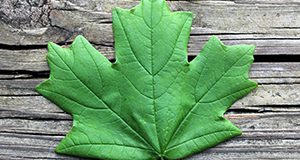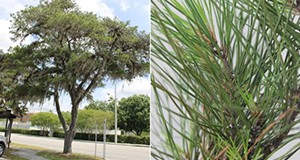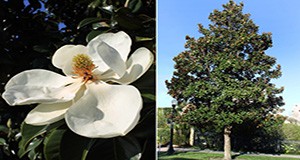A dichotomous key is a tool used to help identify an unknown organism. This twelve-page fact sheet features a key of leaf characteristics for ten common broadleaf trees in the Tampa Bay Area. Accurately navigating this series of paired, either-or choices about leaf characteristics will lead the reader to identify the correct tree from the group of ten. Written by Andrew K. Koeser, Gitta Hasing, Michael G. Andreu, and Melissa H. Friedman and published by the Environmental Horticulture Department.
http://edis.ifas.ufl.edu/ep510
Tag: Melissa H. Friedman
10 Common Palms of the Tampa Bay Area
Palms often serve as key specimens in urban landscape designs. Despite this, their identity is often unknown to Florida’s new, seasonal, and even long-term residents. This ten-page fact sheet serves as a quick reference for some of the most common palms found in North and Central Florida and the Tampa Bay Area in particular. Written by Gitta Hasing, Andrew K. Koeser, Melissa H. Friedman, and Timothy K. Broschat and published by the Environmental Horticulture Department.
http://edis.ifas.ufl.edu/ep506
Ten Common Conifers of the Tampa Bay Area
Conifers are cone-bearing trees often identified by their needles. In addition to their value as landscape trees and lumber and paper sources, they are popular around the holidays as Christmas trees.
This 6-page guide written by Andrew K. Koeser, Holly Finley, Gitta Hasing, Gary W. Knox, and Melissa H. Friedman and published by the Environmental Horticulture Department will assist you in identifying the 10 most common conifers that grow in the Tampa Bay area of Florida. It is an efficient resource for master gardeners, novice tree inventory crews, 4-H forestry teams, and others interested in basic conifer identification.
Ten Common Flowering Trees of the Tampa Bay Area
Blooming trees serve as key focal points in the urban landscape. Florida’s flowering trees can be quite spectacular and leave you wondering, Wow, what tree is that?
This 7-page guide written by Gitta Hasing, Andrew K. Koeser, Gary W. Knox, and Melissa H. Friedman and published by the Environmental Horticulture Department will assist you in identifying the 10 most common flowering trees that grow in the Tampa Bay area of Florida. It is an efficient resource for master gardeners, novice tree inventory crews, 4-H forestry teams, and others interested in basic flowering tree identification.
edis.ifas.ufl.edu/ep505
BOOKSTORE: SP 496 Trees: North & Central Florida ($24.95)
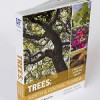 This sturdy, pocket-sized field guide–the only one of its kind for north and central Florida–is designed for landscape professionals, arborists, naturalists, gardeners, and anyone seeking to know the trees around them. Full color photographs of leaves, bark, flowers and full trees, together with clear descriptions and other information make identifying trees easier than ever. The book also features a handy diagnostic key, an introduction to plant parts, a glossary and a ruler to guide you, whether you’re a trained botanist or a total beginner. This field guide to 140 common tree species is written by Andrew Koeser, Gitta Hasing, Melissa Friedman, and Robert Irving and published by UF/IFAS. Available only at the UF/IFAS Extension Bookstore.
This sturdy, pocket-sized field guide–the only one of its kind for north and central Florida–is designed for landscape professionals, arborists, naturalists, gardeners, and anyone seeking to know the trees around them. Full color photographs of leaves, bark, flowers and full trees, together with clear descriptions and other information make identifying trees easier than ever. The book also features a handy diagnostic key, an introduction to plant parts, a glossary and a ruler to guide you, whether you’re a trained botanist or a total beginner. This field guide to 140 common tree species is written by Andrew Koeser, Gitta Hasing, Melissa Friedman, and Robert Irving and published by UF/IFAS. Available only at the UF/IFAS Extension Bookstore.
Pyrus communis, Common Pear (FOR293/FR361)
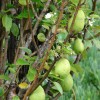 The showy flowers and manageable height of common pear makes it a favorable ornamental landscape tree. Some find the aromatic flowers and sweet edible fruits to be an additional plus; however, a pollinator specimen must be nearby in order for the female tree to produce fruit. Careful consideration should be taken when choosing a planting location, since the soft fruits can be messy if not harvested. This 2-page fact sheet was written by Michael G. Andreu, Melissa H. Friedman, and Robert J. Northrop, and published by the UF Department of School of Forest Resources and Conservation, July 2012.
The showy flowers and manageable height of common pear makes it a favorable ornamental landscape tree. Some find the aromatic flowers and sweet edible fruits to be an additional plus; however, a pollinator specimen must be nearby in order for the female tree to produce fruit. Careful consideration should be taken when choosing a planting location, since the soft fruits can be messy if not harvested. This 2-page fact sheet was written by Michael G. Andreu, Melissa H. Friedman, and Robert J. Northrop, and published by the UF Department of School of Forest Resources and Conservation, July 2012.
http://edis.ifas.ufl.edu/fr361
Casuarina equisetifolia, Australian Pine (FOR298/FR366)
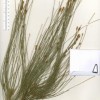 Australian pine was originally planted in Florida in the late 1800’s as a windbreak and for shade. But soon thereafter it was spreading without help from humans. Today it is considered a category I invasive species in Florida, and the Division of Plant Industry strictly prohibits possessing, transporting, and cultivating this species. For those who find this tree in close proximity to their home, it’s a good idea to replace it since Australian pine is known to have a very low resistance to wind. Australian pine is commonly found growing on coastal shorelines since it thrives in salty, sandy environments. This 2-page fact sheet was written by Michael G. Andreu, Melissa H. Friedman, and Robert J. Northrop, and published by the UF Department of School of Forest Resources and Conservation, July 2012.
Australian pine was originally planted in Florida in the late 1800’s as a windbreak and for shade. But soon thereafter it was spreading without help from humans. Today it is considered a category I invasive species in Florida, and the Division of Plant Industry strictly prohibits possessing, transporting, and cultivating this species. For those who find this tree in close proximity to their home, it’s a good idea to replace it since Australian pine is known to have a very low resistance to wind. Australian pine is commonly found growing on coastal shorelines since it thrives in salty, sandy environments. This 2-page fact sheet was written by Michael G. Andreu, Melissa H. Friedman, and Robert J. Northrop, and published by the UF Department of School of Forest Resources and Conservation, July 2012.
http://edis.ifas.ufl.edu/fr366
Tabebuia serratifolia, Yellow Trumpet Tree (FOR303/FR371)
 This deciduous tree is native to South and Central America is commonly planted in Florida as an ornamental landscape and shade tree. It has attractive bright, yellow blossoms produced in the absence of leaves. Once established, this tree is drought tolerant, making it easier to care for and less demanding on water resources. Yellow trumpet tree also has a relatively high tolerance to salt spray, and therefore is an appropriate street tree or yard specimen in coastal areas.This 2-page fact sheet was written by Michael G. Andreu, Melissa H. Friedman, and Robert J. Northrop, and published by the UF Department of School of Forest Resources and Conservation, July 2012.
This deciduous tree is native to South and Central America is commonly planted in Florida as an ornamental landscape and shade tree. It has attractive bright, yellow blossoms produced in the absence of leaves. Once established, this tree is drought tolerant, making it easier to care for and less demanding on water resources. Yellow trumpet tree also has a relatively high tolerance to salt spray, and therefore is an appropriate street tree or yard specimen in coastal areas.This 2-page fact sheet was written by Michael G. Andreu, Melissa H. Friedman, and Robert J. Northrop, and published by the UF Department of School of Forest Resources and Conservation, July 2012.
http://edis.ifas.ufl.edu/fr371
Hippomane mancinella, Manchineel (FOR302/FR370)
 This poisonous tree is native to southern Florida, the Keys, many of the Caribbean islands, Mexico, and Central America. Though it is poisonous to humans and many animals, iguanas are eat the fruit and sometimes live among the tree’s limbs. It’s found along the seacoasts and in brackish swamps where it grows among mangroves. Each leaf has a small gland where the leaf joins the stem. The bark is reddish-to-grayish brown and cracked looking. Flowers inconspicuous, but the spikes or leafless stems that the flowers emerge from are visible. The fruit is bright-green and looks like a small apple. This 2-page fact sheet was written by Michael G. Andreu and Melissa H. Friedman, and published by the UF Department of School of Forest Resources and Conservation, July 2012.
This poisonous tree is native to southern Florida, the Keys, many of the Caribbean islands, Mexico, and Central America. Though it is poisonous to humans and many animals, iguanas are eat the fruit and sometimes live among the tree’s limbs. It’s found along the seacoasts and in brackish swamps where it grows among mangroves. Each leaf has a small gland where the leaf joins the stem. The bark is reddish-to-grayish brown and cracked looking. Flowers inconspicuous, but the spikes or leafless stems that the flowers emerge from are visible. The fruit is bright-green and looks like a small apple. This 2-page fact sheet was written by Michael G. Andreu and Melissa H. Friedman, and published by the UF Department of School of Forest Resources and Conservation, July 2012.
http://edis.ifas.ufl.edu/fr370
Fortunella spp., Kumquat (FOR300/FR368)
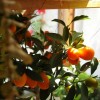 Many people find kumquat trees attractive and useful yard specimens. Their dark green leaves and contrasting bright orange fruits give them ornamental quality, and their relatively small size makes them easy to care for once they’re established. Because kumquats generally require less care than other citrus trees, they may be a good choice for gardeners with less time or experience, but who still desire an attractive and tasty citrus tree. If space is an issue, kumquats also do well in containers as long as they receive proper sunlight and watering. This 2-page fact sheet was written by Michael G. Andreu, Melissa H. Friedman, and Robert J. Northrop, and published by the UF Department of School of Forest Resources and Conservation, July 2012.
Many people find kumquat trees attractive and useful yard specimens. Their dark green leaves and contrasting bright orange fruits give them ornamental quality, and their relatively small size makes them easy to care for once they’re established. Because kumquats generally require less care than other citrus trees, they may be a good choice for gardeners with less time or experience, but who still desire an attractive and tasty citrus tree. If space is an issue, kumquats also do well in containers as long as they receive proper sunlight and watering. This 2-page fact sheet was written by Michael G. Andreu, Melissa H. Friedman, and Robert J. Northrop, and published by the UF Department of School of Forest Resources and Conservation, July 2012.
http://edis.ifas.ufl.edu/fr368
Gleditsia aquatica, Water Locust (FOR301/FR369)
 Water locust’s wide, spreading root system and affinity for hydric conditions makes it a useful specimen for erosion control on wet banks of freshwater systems. While not widely available, planting this tree in residential yards or other public locations may be less than ideal, since the long and sharply pointed thorns on the main trunk and branches can be hazardous. This deciduous tree is native to Florida. This 2-page fact sheet was written by Michael G. Andreu, Melissa H. Friedman, and Robert J. Northrop, and published by the UF Department of School of Forest Resources and Conservation, July 2012.
Water locust’s wide, spreading root system and affinity for hydric conditions makes it a useful specimen for erosion control on wet banks of freshwater systems. While not widely available, planting this tree in residential yards or other public locations may be less than ideal, since the long and sharply pointed thorns on the main trunk and branches can be hazardous. This deciduous tree is native to Florida. This 2-page fact sheet was written by Michael G. Andreu, Melissa H. Friedman, and Robert J. Northrop, and published by the UF Department of School of Forest Resources and Conservation, July 2012.
http://edis.ifas.ufl.edu/fr369
Callistemon salignus, White Bottlebrush (FOR292/FR360)
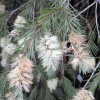 Native to Australia, this evergreen tree has use as an ornamental tree that produces moderate shade along a street, median, or yard. The unique flowering structure is eye-catching and it can be pruned for use as a decorative hedge. Its tolerance of many different soil types and droughty conditions makes it easy to care for after it’s been established. This 2-page fact sheet was written by Michael Andreu, Melissa Friedman, Robert Northrop, and published by the UF Department of School of Forest Resources and Conservation, July 2012.
Native to Australia, this evergreen tree has use as an ornamental tree that produces moderate shade along a street, median, or yard. The unique flowering structure is eye-catching and it can be pruned for use as a decorative hedge. Its tolerance of many different soil types and droughty conditions makes it easy to care for after it’s been established. This 2-page fact sheet was written by Michael Andreu, Melissa Friedman, Robert Northrop, and published by the UF Department of School of Forest Resources and Conservation, July 2012.
http://edis.ifas.ufl.edu/fr360
Cassia grandis, Pink Shower (FOR294/FR362)
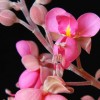 The name “pink shower” comes from the bright pink blossoms that this tree produces. It is sometimes called “stinking tree” because the pulp in its pods has a very strong smell. This 2-page fact sheet was written by Michael G. Andreu, Melissa H. Friedman, and Robert J. Northrop, and published by the UF Department of School of Forest Resources and Conservation, July 2012.
The name “pink shower” comes from the bright pink blossoms that this tree produces. It is sometimes called “stinking tree” because the pulp in its pods has a very strong smell. This 2-page fact sheet was written by Michael G. Andreu, Melissa H. Friedman, and Robert J. Northrop, and published by the UF Department of School of Forest Resources and Conservation, July 2012.
http://edis.ifas.ufl.edu/fr362
Cassia leptophylla, Gold Medallion Tree (FOR295/FR363)
 The gold medallion tree is planted primarily as a shade tree or as a decorative specimen for the yard or street. Many people like this tree because of its fast growth rate and showy, bright yellow clusters of flowers that bloom in the summer months. This tree loses its leaves for a very short period each year, but leaves are quickly replaced. Pruning the tree to one main leading stem from which major branches are attached can help increase its strength and sturdiness against strong wind events. The golden medallion tree is also naturally pest resistant, and as long as it is grown in areas where the temperature does not drop below freezing, it is an easy tree to care for. This 2-page fact sheet was written by Michael G. Andreu, Melissa H. Friedman, and Robert J. Northrop, and published by the UF Department of School of Forest Resources and Conservation, July 2012.
The gold medallion tree is planted primarily as a shade tree or as a decorative specimen for the yard or street. Many people like this tree because of its fast growth rate and showy, bright yellow clusters of flowers that bloom in the summer months. This tree loses its leaves for a very short period each year, but leaves are quickly replaced. Pruning the tree to one main leading stem from which major branches are attached can help increase its strength and sturdiness against strong wind events. The golden medallion tree is also naturally pest resistant, and as long as it is grown in areas where the temperature does not drop below freezing, it is an easy tree to care for. This 2-page fact sheet was written by Michael G. Andreu, Melissa H. Friedman, and Robert J. Northrop, and published by the UF Department of School of Forest Resources and Conservation, July 2012.
http://edis.ifas.ufl.edu/fr363
Cassia afrofistula, Kenyan Cassia (FOR296/FR364)
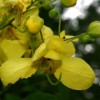 The Kenyan cassia can be used as a showy ornamental tree or shrub, with its dark foliage and bright yellow flowers. Some people find the seed pods to be unattractive and prune the tree after it flowers to prevent pods from developing. This tree tolerates a wide range of soil types and can be used in a garden, park, patio, or streetscape setting. This 2-page fact sheet was written by Michael G. Andreu, Melissa H. Friedman, and Robert J. Northrop, and published by the UF Department of School of Forest Resources and Conservation, July 2012.
The Kenyan cassia can be used as a showy ornamental tree or shrub, with its dark foliage and bright yellow flowers. Some people find the seed pods to be unattractive and prune the tree after it flowers to prevent pods from developing. This tree tolerates a wide range of soil types and can be used in a garden, park, patio, or streetscape setting. This 2-page fact sheet was written by Michael G. Andreu, Melissa H. Friedman, and Robert J. Northrop, and published by the UF Department of School of Forest Resources and Conservation, July 2012.
http://edis.ifas.ufl.edu/fr364
Leucaena leucocephala, White Leadtree (FOR299/FR367)
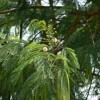 In Florida, white leadtree is a prohibited species and therefore is not used in commercial applications in the state. However, in its native range it is used as a source of charcoal, fuel, and lumber. It has also been planted as a windbreak for crops such as coffee and cocoa, and some ranchers use the tree as a source of both shade and forage for cattle, with the pods being an excellent source of protein. In addition, as white leadtree forms a well-developed taproot, it has been planted to assist with erosion control. This 2-page fact sheet was written by Michael G. Andreu, Melissa H. Friedman, and Robert J. Northrop, and published by the UF Department of School of Forest Resources and Conservation, July 2012.
In Florida, white leadtree is a prohibited species and therefore is not used in commercial applications in the state. However, in its native range it is used as a source of charcoal, fuel, and lumber. It has also been planted as a windbreak for crops such as coffee and cocoa, and some ranchers use the tree as a source of both shade and forage for cattle, with the pods being an excellent source of protein. In addition, as white leadtree forms a well-developed taproot, it has been planted to assist with erosion control. This 2-page fact sheet was written by Michael G. Andreu, Melissa H. Friedman, and Robert J. Northrop, and published by the UF Department of School of Forest Resources and Conservation, July 2012.
http://edis.ifas.ufl.edu/fr367
Cassia javanica, Pink and White Shower (FOR297/FR365)
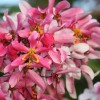 Cassia javanica is planted primarily as a decorative shade tree. Many people consider pink and white shower to be aesthetically pleasing because of its pink and white blooms that emerge during the summer months. Because its leafless season is so short, it can be a good shade tree throughout the year. Its rapid growth rate makes it an ideal tree for homeowners looking to increase their tree cover. And its natural resistance to pests increases its desirability as a landscape tree that is commonly used as an ornamental street tree. This 2-page fact sheet was written by Michael G. Andreu, Melissa H. Friedman, and Robert J. Northrop, and published by the UF Department of School of Forest Resources and Conservation, July 2012.
Cassia javanica is planted primarily as a decorative shade tree. Many people consider pink and white shower to be aesthetically pleasing because of its pink and white blooms that emerge during the summer months. Because its leafless season is so short, it can be a good shade tree throughout the year. Its rapid growth rate makes it an ideal tree for homeowners looking to increase their tree cover. And its natural resistance to pests increases its desirability as a landscape tree that is commonly used as an ornamental street tree. This 2-page fact sheet was written by Michael G. Andreu, Melissa H. Friedman, and Robert J. Northrop, and published by the UF Department of School of Forest Resources and Conservation, July 2012.
http://edis.ifas.ufl.edu/fr365
FOR266/FR328 Ficus citrifolia, Shortleaf fig
FOR266, a 2-page fact sheet by Michael G. Andreu, Melissa H. Friedman, Mary McKenzie, Heather V. Quintana, and Robert J. Northrop, describes this semi-deciduous fig tree that is native to Florida and naturally found in tropical hammocks throughout south Florida, the Caribbean, the Bahamas, the West Indies and some regions in Central America — scientific and common names, description, allergen, and applications. Includes references. Published by the UF School of Forest Resources and Conservation, June 2010.
http://edis.ifas.ufl.edu/fr328
FOR262/FR324 Nyssa aquatica, Water Tupelo
FOR262, a 2-page fact sheet by Michael G. Andreu, Melissa H. Friedman, Mary McKenzie, and Heather V. Quintana, describes this native deciduous tree found in the bottomlands, floodplains, and swamps of southern Virginia, south to northwest Florida, west to southeastern Texas, and north through the Mississippi River Valley — scientific and common names, description, allergen, and applications. Includes references. Published by the UF School of Forest Resources and Conservation, June 2010.
http://edis.ifas.ufl.edu/fr324
FOR263/FR325 Laguncularia racemosa, White Mangrove
FOR263, a 2-page fact sheet by Michael G. Andreu, Melissa H. Friedman, Mary McKenzie, and Heather V. Quintana, describes this native evergreen tree that grows in the coastal areas of south Florida, the Caribbean, and Central America — scientific and common names, description, storm tolerance, and applications. Includes references. Published by the UF School of Forest Resources and Conservation, June 2010.
http://edis.ifas.ufl.edu/fr325
